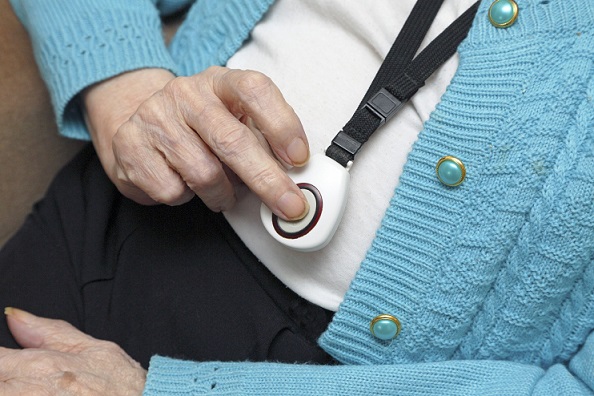Medical alert systems are a critical tool for caring for aging seniors. Whether they live alone or want greater independence, these alert systems can mean the difference between life and death when there is an emergency. In the past medical alert systems relied on phone technology, which meant that when the phone lines went down, so did the alert system. Some newer systems have multiple redundancies and can connect via cell towers, internet, and phone. This means that users are more likely to reach someone in the event of an emergency.
Medical Alert Systems Overview
If you’re wondering what medical alert systems are exactly, they are devices that allow users to connect with someone if there is an emergency. What makes them different from using a telephone is that they are often wearable and can connect at the touch of a button. In a medical emergency, seniors can use them if they’ve fallen, if they’ve injured themselves, and if they need other urgent medical assistance. Because the devices are wearable, they don’t need to fear whether or not they can connect with someone and get the help they need. These wearable medical alert systems — or MAS — come in the form of wristbands, necklaces, and wall-mounted devices.
These systems connect through landline telephone systems, cellular phone systems, and even internet lines. Some connect through all three in order to provide redundancies. This can give peace of mind to seniors living alone that they can always reach someone. It can also help caregivers and family members feel confident in giving their loved ones more independence. The benefit of some devices is that they also provide GPS coordinates. This is especially helpful for individuals with dementia and Alzheimer’s disease. If they wander off, these devices can help family and medical teams locate them quickly. Emergency alert systems come with many different options, at different price points so that almost anyone can use them.
Benefits of Medical Alert Systems
According to Health.com, 1 in 4 older adults are injured during falls each year. Some of these falls are minor, but others lead to major injuries like broken hips, fractured ribs, and even head injuries. These falls can leave elderly individuals scared and unable to move. If they hurt their heads, they can be confused and unable to call. These MAS devices give them an easy way to reach out for help. They typically have large obvious buttons to help people get the help they need as quickly as possible.
Another benefit to these systems is that they can help seniors manage their other diseases. When they are experiencing minor symptoms, they can reach out for help from medical professionals through their alert systems. Health.com suggests that this connectivity can help people get earlier help if they use this system to report symptoms and ask questions.
Greater Independence and Peace of Mind
Growing older comes with a lot of unknowns. Using a medical alert system helps to alleviate the fear of getting injured and having no one nearby to help. This can allow older adults to continue living in their own home instead of moving to a care facility. With this peace of mind, caregivers can know that they are comfortable in their home and safer.
Simple to Use
No one needs to memorize a special code. Medical alert systems are simple with large obvious buttons that don’t take too much effort to push. They also connect you directly to a human instead of a confusing bot-enables call system. This simplicity gives people more confidence to use the device when they need it most.
How to Pick the Best Medical Alert System for your Needs
With so many MAS options on the market, it can be overwhelming to choose the best one. While there are many features, it’s important to look at your overall lifestyle and how a medical alert device can help.
Do I need help on the go or only at home?
If you’re someone who likes to go out alone, then having a MAS system that goes with you can make it easy to get assistance when you need it. At-home systems have a base station usually attached to a phone landline to simplify reaching out. If no landline is available, many of them can also connect through internet lines. When you hit the button on the console, you can be connected to an operator instantly. If you need help, they will send it right away. A button on a necklace or wristband will also connect you if you aren’t near the console. For help when you’re not at home, these devices often use mobile technology similar to a cell phone to connect to the operator just as easily.
Do I need something to detect a fall automatically?
Seniors who are at a greater fall risk, may need something that can detect a fall without needing to click a button. Health.com explains that seniors who have had previous falls or have limited mobility would be good candidates for this type of service. For those who experience seizures, struggle with regulating blood sugar, or who get sudden changes in blood pressure would also be good candidates. Most companies offer fall detection for only $10 a month and the added protection can provide a tremendous amount of peace of mind and can swiftly get help to someone who needs it.
Are Medical Alert Systems Affordable?
Medical Alert systems range in price from $20-$60 per month. Each one provides a different level of service. The most basic home systems are still beneficial for seniors living alone. While people living on fixed incomes from retirement, social security, and other pensions may find it difficult to budget for a new monthly service, these services are critical especially for independent seniors living alone. Additionally, the Health.com article mentions the fact that there are ways to get big discounts on these systems. AARP members can expect to get discounts from many different companies even on medical alert systems. You can also ask the company directly for a discount. Many companies provide senior discounts if you ask.
Should You Get a Medical Alert System?
After evaluating all the benefits, you may be wondering if you should get one. While many companies require long contracts, some can be month-to-month if you buy the device. It’s important to call multiple companies to find the options you need and how they can help. The article in Health.com has expert reviews of many different systems to help you make the best choice.








